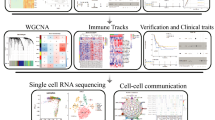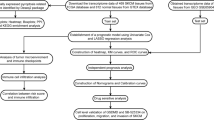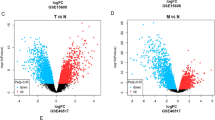Abstract
Background
Skin cutaneous melanoma (SKCM) is an aggressive and life-threatening skin cancer. G-protein coupled receptor 143 (GPR143) belongs to the superfamily of G protein-coupled receptors.
Methods
We used the TCGA, GTEx, CCLE, and the Human Protein Atlas databases to examine the mRNA and protein expression of GPR143. In addition, we performed a survival analysis and evaluated the diagnostic efficacy using the Receiver-Operating Characteristic (ROC) curve. Through CIBERSORT, R programming, TIMER, Gene Expression Profiling Interactive Analysis, Sangerbox, and Kaplan-Meier plotter database analyses, we explored the relationships between GPR143, immune infiltration, and gene marker expression of immune infiltrated cells. Furthermore, we investigated the proteins that potentially interact with GPR143 and their functions using R programming and databases including STRING, GeneMANIA, and GSEA. Meanwhile, the cBioPortal, UALCNA, and the MethSurv databases were used to examine the genomic alteration and methylation of GPR143 in SKCM. The Connectivity Map database was used to discover potentially effective therapeutic molecules against SKCM. Finally, we conducted cell experiments to investigate the potential role of GPR143 in SKCM.
Results
We demonstrated a significantly high expression level of GPR143 in SKCM compared with normal tissues. High GPR143 expression and hypomethylation status of GPR143 were associated with a poorer prognosis. ROC analysis showed that the diagnostic efficacy of the GPR143 was 0.900. Furthermore, GPR143 expression was significantly correlated with immune infiltration in SKCM. We identified 20 neighbor genes and the pathways they enriched were anabolic process of pigmentation, immune regulation, and so on. Genomic alteration analysis revealed significantly different copy number variations related to GPR143 expression in SKCM, and shallow deletion could lead to high expression of GPR143. Ten potential therapeutic drugs against SKCM were identified. GPR143 knockdown inhibited melanoma cell proliferation, migration, and colony formation while promoting apoptosis.
Conclusions
Our findings suggest that GPR143 serves as a novel diagnostic and prognostic biomarker and is associated with the progression of SKCM.










Similar content being viewed by others
Data Availability
TIMER (https://cistrome.shinyapps.io/timer/); CCLE (https://portals.broadinstitute.org/ccle); HPA (http://www.proteinatlas.org); CIBERSORT (http://cibersort.stanford.edu/); GEPIA (http://gepia.cancer-pku.cn/); Sangerbox (http://vip.sangerbox.com/home.html); UALCAN (http://ualcan.path.uab.edu); MethSurv (https://biit.cs.ut.ee/methsurv/); miRWalk (http://mirwalk.umm.uni-heidelberg.de/); miRDB (http://mirdb.org/); miRabel (http://bioinfo.univ-rouen.fr/mirabel/); CancerMIRNome (http://bioinfo.jialab-ucr.org/CancerMIRNome); Kaplan-Meier plotter (http://kmplot.com); STRING (http://string-db.org); GeneMANIA (http://www.genemania.org); cBioPortal (http://cbioportal.org); the UCSC Xena Browser (https://xena.ucsc.edu/); (CMap) (https://clue.io/).
References
Long GV et al (2023) Cutaneous Melanoma. Lancet (London England) 402(10400):485–502
Miller KD et al (2022) Cancer treatment and survivorship statistics, 2022. Cancer J Clin 72(5):409–436
Carlino MS, Larkin J, Long GV (2021) Immune checkpoint inhibitors in Melanoma. Lancet 398(10304):1002–1014
Seth R et al (2020) Systemic therapy for Melanoma: ASCO Guideline. J Clin Oncol 38(33):3947–3970
Reichert C et al (2023) Combined Nivolumab and Ipilimumab in Octogenarian and Nonagenarian Melanoma patients. Cancers (Basel), 15(17)
Anestopoulos I et al (2022) Targeting the epigenome in malignant Melanoma: facts, challenges and therapeutic promises, vol 240. Pharmacology & Therapeutics, p 108301
Boire A et al (2020) Brain Metastasis. Nat Rev Cancer, 20(1)
Gu Y et al (2023) PCSK9 facilitates Melanoma pathogenesis via a network regulating Tumor immunity. J Experimental Clin Cancer Research: CR 42(1):2
Dong Q et al (2023) MARCO is a potential prognostic and immunotherapy biomarker. Int Immunopharmacol 116:109783
Xue W et al (2022) DIRAS2 is a prognostic biomarker and linked with Immune infiltrates in Melanoma. Front Oncol 12:799185
Zhou S et al (2022) TIMM13 as a prognostic biomarker and associated with immune infiltration in skin cutaneous Melanoma (SKCM). Front Surg 9:990749
Gao X et al (2020) A novel GPR143 mutation in a Chinese family with X–linked ocular albinism type 1. Mol Med Rep 21(1):240–248
Arcadepani FB, Gadelha A, Margolis RL (2023) Mutation of GPR143 Associated with ocular albinism type 1, intellectual disability, and Schizophrenia: the Complex Biological and Social Interactions between Genetic Syndromes and Mental Illness. J Psychiatr Pract 29(1):77–81
Lee YJ et al (2023) GPR143 controls ESCRT-dependent exosome biogenesis and promotes cancer Metastasis. Dev Cell, 58(4)
Cheng A et al (2021) Upregulation of ZHX2 predicts poor prognosis and is correlated with immune infiltration in gastric cancer. FEBS Open Bio 11(6):1785–1798
Ma Y, Zhou X (2022) Spatially informed cell-type deconvolution for spatial transcriptomics. Nat Biotechnol 40(9):1349–1359
Nusinow DP et al (2020) Quant Proteom Cancer Cell Line Encyclopedia Cell, 180(2)
Rozanova S et al (2021) Quantitative Mass Spectrometry-Based Proteomics: An Overview Methods In Molecular Biology (Clifton, N.J.), 2228
Chandrashekar DS et al (2022) UALCAN: an update to the integrated cancer data analysis platform, vol 25. Neoplasia, New York, N.Y.), pp 18–27
Modhukur V et al (2018) MethSurv: a web tool to perform multivariable survival analysis using DNA methylation data. Epigenomics 10(3):277–288
Sticht C et al (2018) miRWalk: an online resource for prediction of microRNA binding sites. PLoS ONE 13(10):e0206239
Chen Y, Wang X (2020) miRDB: an online database for prediction of functional microRNA targets. Nucleic Acids Res 48(D1):D127–D131
Quillet A et al (2019) Improving Bioinformatics Prediction of microRNA targets by Ranks Aggregation. Front Genet 10:1330
Gentles AJ et al (2015) The prognostic landscape of genes and infiltrating immune cells across human cancers. Nat Med 21(8):938–945
Tang Z et al (2017) GEPIA: a web server for cancer and normal gene expression profiling and interactive analyses. Nucleic Acids Res 45(W1):W98–w102
Thorsson V et al (2018) The Immune Landscape of Cancer. Immunity, 48(4)
Gyorffy B, Lánczky A, Szállási Z (2012) Implementing an online tool for genome-wide validation of survival-associated biomarkers in Ovarian-cancer using microarray data from 1287 patients. Endocrine-related Cancer 19(2):197–208
Szklarczyk D et al (2023) The STRING database in 2023: protein-protein association networks and functional enrichment analyses for any sequenced genome of interest. Nucleic Acids Res 51(D1):D638–D646
Franz M et al (2018) GeneMANIA update 2018. Nucleic Acids Res 46(W1):W60–W64
Liu X-S et al (2021) NPM1 is a prognostic biomarker involved in Immune Infiltration of Lung Adenocarcinoma and Associated with m6A modification and Glycolysis. Front Immunol 12:724741
Yue T et al (2021) The aging-related risk signature in Colorectal cancer. Aging 13(5):7330–7349
Subramanian A et al (2017) A Next Generation Connectivity Map: L1000 platform and the first 1,000,000 profiles. Cell, 171(6)
Vivian J et al (2017) Toil enables reproducible, open source, big biomedical data analyses. Nat Biotechnol 35(4):314–316
Goldman MJ et al (2020) Visualizing and interpreting cancer genomics data via the Xena platform. Nat Biotechnol 38(6):675–678
Singh N et al (2020) An integrative network-driven pipeline for systematic identification of lncRNA-associated regulatory network motifs in metastatic Melanoma. BMC Bioinformatics 21(1):329
Ye L et al (2019) Tumor-infiltrating Immune cells Act as a marker for prognosis in Colorectal Cancer. Front Immunol 10:2368
Azimi F et al (2012) Tumor-infiltrating lymphocyte grade is an Independent predictor of sentinel lymph node status and survival in patients with cutaneous Melanoma. J Clin Oncol 30(21):2678–2683
Ge Y et al (2017) Stem Cell Lineage Infidelity Drives Wound Repair and Cancer Cell, 169(4)
Malta TM et al (2018) Machine learning identifies stemness features Associated with Oncogenic Dedifferentiation. Cell, 173(2)
Bonneville R et al (2017) Landscape of Microsatellite Instability Across 39 Cancer Types JCO Precision Oncology, 2017
Tawbi HA et al (2022) Relatlimab and Nivolumab versus Nivolumab in Untreated Advanced Melanoma. N Engl J Med 386(1):24–34
Stratton MR, Campbell PJ, Futreal PA (2009) The cancer Genome Nature 458(7239):719–724
Mermel CH et al (2011) GISTIC2.0 facilitates sensitive and confident localization of the targets of focal somatic copy-number alteration in human cancers. Genome Biol 12(4):R41
Skvortsova K, Stirzaker C, Taberlay P (2019) The DNA methylation landscape in cancer. Essays Biochem 63(6):797–811
Sang Y, Deng Y (2019) Current insights into the epigenetic mechanisms of Skin cancer. Dermatol Ther 32(4):e12964
Bonilla C et al (2021) Investigating DNA methylation as a potential mediator between pigmentation genes, pigmentary traits and Skin cancer. Pigment Cell Melanoma Res 34(5):892–904
Wu S, Zang Q, Dai B (2021) The role of NLRP3 in the prognosis and immune infiltrates of skin cutaneous Melanoma (SKCM). Transl Cancer Res 10(4):1692–1702
Wu S et al (2021) A Pan-cancer analysis of the BIRC Gene Family and its Association with Prognosis, Tumor Microenvironment, and therapeutic targets. Crit Rev Eukaryot Gene Expr 31(4):35–48
Liu Y et al (2016) CD11b + Ly6G + cells inhibit Tumor growth by suppressing IL-17 production at early stages of tumorigenesis. Oncoimmunology 5(1):e1061175
Dai X et al (2019) Key indexes and the emerging tool for Tumor microenvironment editing. Am J Cancer Res 9(5):1027–1042
Wang J et al (2020) Silencing Signal Transducer and activator of transcription 3 (STAT3) and use of anti-programmed cell death-ligand 1 (PD-L1) antibody induces Immune Response and Anti-tumor Activity. Med Sci Monit 26:e915854
Jiang S et al (2022) Identifying immune cells-related phenotype to predict immunotherapy and clinical outcome in gastric cancer. Front Immunol 13:980986
Peng Y-L et al (2022) Single-cell transcriptomics reveals a low CD8 + T cell infiltrating state mediated by fibroblasts in recurrent renal cell carcinoma. J Immunother Cancer, 10(2)
Nakamura Y (2019) Biomarkers for Immune Checkpoint inhibitor-mediated Tumor Response and adverse events. Front Med (Lausanne) 6:119
Hanoteau A et al (2019) Tumor microenvironment modulation enhances immunologic benefit of chemoradiotherapy. J Immunother Cancer 7(1):10
Fukuda N et al (2015) Expression of ocular albinism 1 (OA1), 3, 4- dihydroxy- L-phenylalanine (DOPA) receptor, in both neuronal and non-neuronal organs. Brain Res 1602:62–74
McKay BS (2019) Pigmentation and vision: is GPR143 in control? J Neurosci Res 97(1):77–87
Schiaffino MV (2010) Signaling pathways in melanosome biogenesis and pathology. Int J Biochem Cell Biol 42(7):1094–1104
Zoeller RA, Geoghegan-Barek K (2019) A cell-based high-throughput screen identifies tyrphostin AG 879 as an inhibitor of animal cell phospholipid and fatty acid biosynthesis. Biochem Biophys Rep 18:100621
Jeong H-S et al (2010) Induction of cell growth arrest and apoptotic cell death in human Breast cancer MCF-7 cells by the COX-1 inhibitor FR122047. Oncol Rep 24(2):351–356
Shan S et al (2023) Triciribine attenuates pathological neovascularization and vascular permeability in a mouse model of proliferative retinopathy, vol 162. Biomedicine & Pharmacotherapy = Biomedecine & Pharmacotherapie, p 114714
Zixuan X et al (2021) Research Square.
Acknowledgements
We would like to thank all the participants and research staff at the School of Pharmacy, Health Science Center, Xi’an Jiaotong University for their invaluable contributions to this work. A preprint has previously been published [62].
Funding
Our study was supported by the Natural Science Basic Research Plan in Shaan’xi Province of China (Grant no. 2019JQ-596), the Fundamental Research Funds for the Central Universities (xjj2018167 and xzy012020056), the Post-doctoral Sciences Foundation of Shaan’xi Province (Grant no. 2018BSHEDZZ91) and National Natural Science Foundation of China (81802788).
Author information
Authors and Affiliations
Contributions
R.B, P.Y, Z.X and S.W were major contributors in methodology, investigation, and writing. W.Z, X.M, X.G, Y.L, Q.Z, H.L, Y.W, and C.Z were responsible for the formal analysis and data curation. S.W, B.D, and Y.Z were responsible for the conceptualization and production of this study. All authors wrote the original draft and approved the final manuscript.
Corresponding authors
Ethics declarations
Competing interests
The authors declare no competing interests.
Ethical approval
Not applicable.
Consent for publication
Not applicable.
Additional information
Publisher’s Note
Springer Nature remains neutral with regard to jurisdictional claims in published maps and institutional affiliations.
Electronic supplementary material
Below is the link to the electronic supplementary material.
10495_2023_1913_MOESM1_ESM.docx
Supplementary Material 1: See Tables S1-S4 and Fig. S1 in the Supplementary Material for comprehensive data analysis. Table S1 and Table S2 are supplements to Fig. 5. Table S3 and Table S4 are supplements to Fig. 7E-F
Rights and permissions
Springer Nature or its licensor (e.g. a society or other partner) holds exclusive rights to this article under a publishing agreement with the author(s) or other rightsholder(s); author self-archiving of the accepted manuscript version of this article is solely governed by the terms of such publishing agreement and applicable law.
About this article
Cite this article
Bai, R., Yin, P., Xing, Z. et al. Investigation of GPR143 as a promising novel marker for the progression of skin cutaneous melanoma through bioinformatic analyses and cell experiments. Apoptosis 29, 372–392 (2024). https://doi.org/10.1007/s10495-023-01913-6
Accepted:
Published:
Issue Date:
DOI: https://doi.org/10.1007/s10495-023-01913-6




